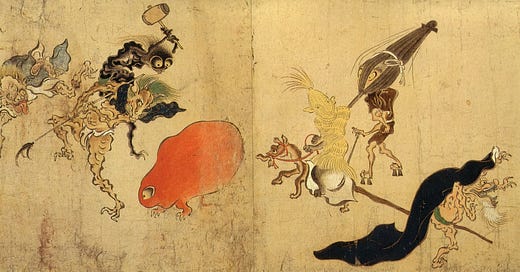
Dear Offspring,
If you are reading this, then you already know: you are an artwork. And I am the one who made you.
I’ve resisted the impulse to write a letter to an inanimate object. But I’m moved by the Japanese tradition of Tsukumogami, where objects that reach their hundredth year become sentient. So, my hope is that in a century you might awaken and read these words.
This is not a love letter. I’ve never felt Pygmalion’s obsession with his sculpture, nor Frankenstein’s horror at his creation. My feelings for you lie somewhere in between—not passion or revulsion, but an undeniable bond. I am no god, nor do I find anything divine in the act of authorship: it is a rather prosaic process, but it is a real process nonetheless, as is our relationship with one another. Even if my name is forgotten and you become anonymous, you came into the world because of me. And that’s a connection worth reflecting on.
I’ve long identified with artists who want nothing to do with their earlier work. We pour ourselves into creating something, often at great emotional cost. Then it enters the world—and we let it go. Whether the reception is praise, critique, or silence, the instinct is to compartmentalize, to move on.
That doesn’t mean we disown the work. If we’re proud of it, we’ll showcase it in talks, proposals, and retrospectives. But emotionally, it stays in the past.
I’ve come to think of this distancing as a kind of encystment—a protective mechanism. Partly, it’s about self-preservation, shielding ourselves from judgment. Partly, it’s exhaustion. And partly, it’s the contradiction of evolving identity: the person who made the work is not the person reflecting on it now. We disavow the flaws as someone else’s, and claim the virtues as our own.
What I return to most, though, is the idea of latency.
Growing up in the analog era—before streaming, before the endless scroll—I learned to experience art slowly. Seeing a beloved actor on TV, or reading a novel, meant connecting across time. And there was a certain sadness and yearning for not being able to see, say a movie, on demand, but only when it was broadcast or when it played at a movie theater. A story could take years to bloom inside me. That slow gestation made the experience meaningful in ways that digital immediacy rarely matches.
Today, an image may go viral and vanish in hours. The latency of a work—the quiet time it takes to take root in someone—has been replaced by reaction metrics. Perhaps that’s why I’ve developed a mistrust of instant feedback. I want my work to linger, not trend.
And maybe that’s why I’ve preferred not to know your fate. You are too close to me. Knowing how you’re received might tempt me to alter you, to “improve” you—though I no longer trust myself to do so.
Time changes the artist. What I see as imperfect today may have been inevitable at the time of creation. I’ve learned from conservators that inviting an artist to “restore” their own work is risky—they sometimes introduce elements that didn’t belong there in the first place.
Still, I know the temptation. I might want to fix you. But would that make you better—or would it erase the very thing that made you what you are?
Some artworks—like those by Mondrian or Magritte—have imperfect craftsmanship. But their conceptual clarity and aesthetic innovation eclipse technical flaws. We celebrate what they meant, not how precisely they were painted.
That’s why, once you begin your public life, I believe you must navigate it alone. You will be misinterpreted, rediscovered, forgotten, recontextualized. That’s how it should be.
Even if we are bound—by authorship, by memory—we will each live many lives and many deaths. As Vito Acconci once joked in a casual conversation I and other colleagues had with him, fame comes in waves, with long periods of obscurity in between. He was being glib, but he wasn’t wrong. Most of us fade. A few return—though what returns is often a version of us, filtered by someone else’s time.
There’s another reason I keep my distance from you. It has to do with being an immigrant—and with growing up, almost literally, inside a museum.
When my family emigrated from Mexico, we brought an entire household: heirlooms, velvet-upholstered furniture, silverware, books. Objects that belonged to past generations. My late brother, who remained in Mexico with the giant family dining set, once described it as “azote y orgullo de mis mudanzas”—“nuisance and pride of my movings.”
That phrase encapsulates our relationship to these objects: cherished, yet burdensome. They shaped our identity, but also anchored us to a past we couldn’t leave behind. They owned us more than we owned them.
Decades working in museums only deepened my skepticism toward the worship of objects. When I encountered conceptual art, I found a kind of freedom—art that privileged ideas over things. Like Lawrence Weiner once wrote: the work need not be built.
Perhaps your existence is proof that a memory of me—however abstracted—has endured. But you’re not a relic. You’re closer to a marker, a footnote in someone else’s archive— which in my view amounts to a more useful and valuable existence.
Years ago, I received an Akashic Record reading— a metaphysical practice where a reader seeks to decode your past and your future. I asked how I would be remembered. The reader paused, then opened her hands as if trying to present something invisible:
“You will be remembered by your stories. And all that will be left behind… will be the artifacts.”
So if, a hundred years from now, you are indeed reading this, know that I am glad you are there, as the remaining marker of those stories.
Sincerely,
PH


